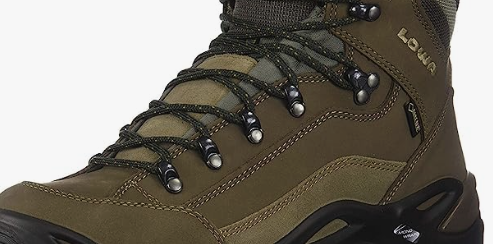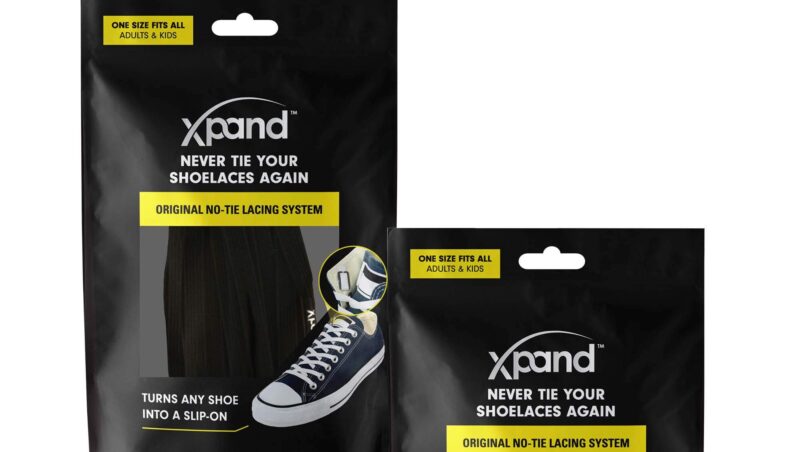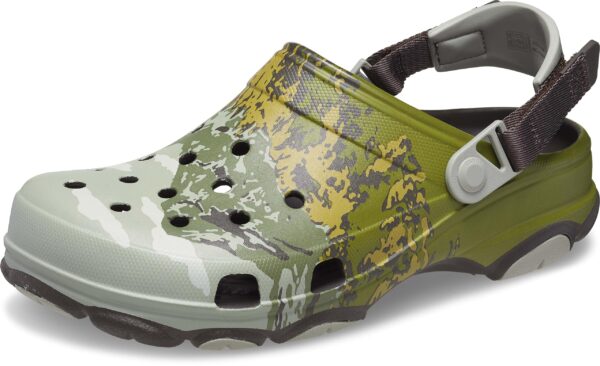As an outdoor guide or adventurer, you prioritize reliable and supportive footwear while tackling various terrains. Hiking boots play a crucial role in providing comfort, stability, and protection during your expeditions. With a wide range of options available on the market, it’s essential to understand the key factors to look for when selecting the ideal hiking boots for your needs.
You’ll want to consider factors like fit, weight, ankle support, traction, and waterproof capabilities when evaluating potential options. Some of the top-rated hiking boots this year include the Salomon X Ultra 4 Mid GTX, Merrell Moab 3 Mid Waterproof, and the Lowa Renegade GTX Mid Hiking Boots. However, personal preference and the specific requirements of your adventures will ultimately dictate the best choice for you.
Top 3 Hiking Boots For Outdoor Adventures
Functionality aside, finding the right pair of hiking boots often comes down to their compatibility with your feet. That means trying on different brands, sizes, and models to determine the most suitable option, while keeping in mind factors such as foot width, arch support, and required insulation. Don’t forego comfort for style or popular trends – enjoying the great outdoors fully depends on putting your best foot forward in the right footwear.
Types of Hiking Boots and Shoes
As you venture into the world of outdoor activities, it’s crucial to understand the various types of hiking footwear available. In this section, we’ll explore three main categories: hiking shoes, backpacking boots, and mountaineering boots.
Hiking Shoes
These shoes are perfect for day hikes and light backpacking trips. Hiking shoes offer more flexibility than boots, providing greater comfort during your hikes. They are often low-cut with flexible midsoles, designed for lighter loads and well-groomed trails. Some ultralight backpackers may even choose trail-running shoes for long-distance journeys. To explore a range of hiking shoes, you can check out REI’s recommendations.
Backpacking Boots
Backpacking boots are a step up from hiking shoes, offering more support and durability. They are typically mid- to high-cut models, intended for day hikes or short backpacking trips with light loads. They provide better ankle support and improved protection for your feet when traversing rugged terrain. You may be interested in Danner Trail 2650 GTX Mid as an example of a day hiking boot.
Mountaineering Boots
For those adventurous souls who dare to tackle extreme outdoor challenges, mountaineering boots are the best choice. These boots are designed for high altitudes and extreme weather conditions, offering superior insulation, stiff soles for crampon compatibility, and excellent ankle support. Mountaineering boots are made to handle the most unforgiving terrains, ensuring that your feet stay protected throughout your adventure.
Now that you have a better understanding of the different types of hiking footwear, choose the one that best fits your outdoor activity and preferred level of comfort. It is essential to invest in the right kind of footwear to make your outdoor experiences safe and enjoyable.
Key Features to Consider
As an outdoor guide or adventurer, selecting the right hiking boots is crucial. In this section, we’ll cover the key features to consider while choosing hiking boots, including Material and Construction, Ankle Support and Stability, and Sole Traction and Durability.
Material and Construction
The material of your hiking boots can play an essential role in their performance, longevity, and overall comfort. We’ll discuss some common materials and their characteristics below:
- Leather: Leather boots are known for their durability, support, and water resistance. Full-grain leather is highly durable, though it may require a break-in period before becoming comfortable. For a more supple option, consider suede leather, which is softer and more adaptable.
- Gore-Tex: A popular waterproof and breathable material, Gore-Tex is found in many hiking boots, allowing your feet to breathe while keeping moisture out.
- Synthetic: Materials such as nylon or polyester can be lighter and more affordable, though they might not offer the same durability and support as leather, and may be more prone to wear and tear.
Consider the desired balance between durability, breathability, and overall comfort when choosing the construction material for your hiking boots.
Ankle Support and Stability
As an outdoor professional, you need hiking boots that provide excellent ankle support and stability. The boots should have enough rigidity and cushioning to help prevent ankle rolls or sprains on uneven terrain. Mid-cut and high-cut models often provide more ankle support than low-cut shoes.
Additionally, good boots will have a stable platform and be well-suited for walking across various terrains. TPU (thermoplastic polyurethane) shanks in the midsole can enhance stability and torsional rigidity without adding too much weight.
Sole Traction and Durability
Equally important is the traction and durability of your hiking boot’s soles. A good sole will provide grip and traction on a range of surfaces, from muddy trails to rocky inclines. Vibram outsoles are often considered a gold standard for grip and durability.
Keep in mind that the more rugged the sole, the more durable it will be, but some trade-offs might include added weight or reduced flexibility. Ultimately, you will need to choose a hiking boot that meets your specific needs for support, stability, and long-term durability.
Finding the Perfect Fit
Finding the perfect fit for your hiking boots is essential for outdoor guides and adventurers like yourself. A well-fitting pair of boots ensures comfort, prevents injuries, and enhances your performance on the trail.
Foot Shape and Width
First, consider your foot shape and width. Hiking boots should fit snug everywhere, tight nowhere, and offer room to wiggle your toes1. Try them on at the end of the day, after your feet have swollen, and with the socks you plan to wear.
For those with wider feet, consider options with a wider toe box, like the Altra Lone Peak ALL-WTHR Mid, which allows your toes to splay out comfortably. On the other hand, if you have narrow feet, opt for boots specifically designed for a narrower foot shape.
Break-in Period
Most hiking boots require a break-in period to stretch and conform to the shape of your feet. During this time, wear your boots as often as possible in non-demanding situations, such as short walks or around your home.
Keep in mind that some boots may have a longer break-in period than others, so be patient and allow for any necessary adjustments. If you experience any discomfort, such as pinching or excessive tightness, it’s better to address these issues sooner rather than later to prevent issues on the trail.
Top Brands and Models
When it comes to hiking boots for outdoor guides and adventurers, there are a few standout brands and models that have become popular choices in the industry. In this section, we’ll dive into three of those favorites: Salomon, Altra Lone Peak, and Teva Grandview.
Salomon
Salomon is a top choice for many outdoor enthusiasts, known for their impressive selection of high-quality hiking boots. One of their most popular models is the Salomon Quest 4 GTX, which boasts excellent stability, comfort, and versatility for long adventures on demanding trails. Another fan favorite is the Salomon X Ultra 4 Mid GTX, renowned for its overall performance and durability.
| Model | Benefits |
|---|---|
| Salomon Quest 4 GTX | Stability, comfort, for demanding trails |
| Salomon X Ultra 4 Mid GTX | Performance, durability |
Altra Lone Peak
For hikers looking for a comfortable, lightweight boot, Altra Lone Peak is an excellent choice. Their Altra Lone Peak 7 is often praised for its innovative design and generous toe box, providing a pleasant experience even on long hikes. This boot is perfect for those who value comfort and a more natural fit.
Teva Grandview
Teva is another popular brand among outdoor enthusiasts, with the Teva Grandview standing out as a versatile and reliable hiking boot. Offering a balance of comfort, support, and durability, it’s an ideal choice for guides and adventurers seeking a dependable option for various terrains.
In summary, when looking for the right hiking boots for your outdoor adventures, consider exploring these top brands and models. Each of them has something unique to offer, ensuring you find the perfect fit for your needs.
Waterproofing and Weather Considerations
When selecting hiking boots, one of the key factors to consider is their ability to withstand various weather conditions and keep your feet dry and comfortable. In this section, we will discuss waterproof membranes, insulation, and summer hiking considerations for outdoor guides and adventurers.
Waterproof Membranes
Choosing a hiking boot with a reliable waterproof membrane such as Gore-Tex or eVent is crucial for dealing with wet environments. A waterproof membrane acts as a barrier between your feet and water, keeping them dry even when exposed to rain, puddles, or crossing streams. Waterproof boots also need to shed water from their exterior, so look for materials that are both waterproof and breathable, allowing moisture to escape while preventing water from entering the boot.
Insulation
In colder climates, adequate insulation is essential for keeping your feet warm and comfortable. Many hiking boots feature varying degrees of insulation to suit different weather conditions. A good pair of insulated boots will help maintain proper blood circulation and prevent frostbite during winter hikes. Make sure to consider the insulation level that best suits your intended hiking activities, as too much insulation can cause your feet to overheat, leading to discomfort or even blisters.
Summer Hiking
During the summer months, choosing hiking boots that provide optimal breathability and ventilation is essential for preventing your feet from overheating. Look for boots made of lighter materials with mesh panels, which allow air circulation and help keep your feet cool. In addition, opt for boots with thinner insulation or no insulation at all, as the warmer climate makes heavy insulation unnecessary. Remember that water resistance is still an important factor to consider during summer hikes, as you may need to cross rivers or encounter unexpected rainstorms.
By considering the waterproofing, insulation, and weather-appropriate features of your hiking boots, you can ensure a more comfortable and enjoyable outdoor experience in various weather conditions.
Socks and Additional Gear
While choosing the perfect pair of hiking boots is important, it’s also essential to select the right socks and other hiking gear. Let’s discuss some options that can enhance your outdoor experiences.
Consider investing in high-quality hiking socks, which provide support and moisture management, keeping your feet dry and comfortable. Top choices like the Danish Endurance Unisex Merino pack or the Darn Tough Hiker Quarter Cushion Socks are made of moisture-wicking materials like merino wool and feature strategic design elements for better breathability.
As for additional gear, there are several items that can make a difference during your hikes:
- Trekking poles: These poles can help reduce stress on your knees and improve balance on uneven terrain.
- Navigation tools: Equip yourself with a map, compass, or GPS device to ensure you stay on the right path and avoid getting lost.
- First Aid Kit: A small, portable first aid kit is essential to address minor injuries and keep you safe on the trail.
- Weather-appropriate clothing: Layering your clothes and wearing weather-resistant outerwear can help regulate your body temperature during unpredictable weather conditions.
- Hydration system: Stay hydrated by carrying a water bottle or using a hydration pack, which can make it easier for you to drink while on the move.
By carefully selecting your socks and packing essential additional gear, you can ensure a more enjoyable and safe hiking experience. Remember to always consider the specific requirements of your hiking adventure, which may vary based on weather, terrain, and trip duration.
Trail and Terrain Suitability
Finding the right hiking boots for your outdoor adventures involves considering the type of terrain and trails you’ll be exploring. In this section, we’ll discuss the trail and terrain suitability for different types of boots.
Technical Terrain
Technical terrains, such as the Rocky Mountains, often feature steep slopes, uneven surfaces, and loose rocks. As an outdoor guide or avid adventurer, navigating this type of terrain requires boots that offer excellent support, protection, and grip.
For tackling technical terrains, you’ll benefit from boots with stiff, durable soles that can withstand rough surfaces. Additionally, a high ankle support ensures stability and reduces the risk of injury. Features like waterproofing and a high-quality lacing system will keep your feet comfortable and secure during long hikes. One example of a boot suitable for technical terrains is the Salomon Quest 4 Gore-Tex.
Well-Maintained Trails
For well-maintained trails such as the Pacific Crest Trail, you may not require the heavy-duty features found in boots designed for technical terrains. Lighter, more agile options will likely suffice on these predictable paths.
Mid-cut, lightweight boots with good cushioning and a comfortable fit, like the Salomon X Ultra Mid 3, are an ideal choice. These boots provide ample support for day hikes and long-distance treks without the extra weight and stiffness of technical terrain boots.
With a focus on support, comfort, and weight, your choice of hiking boots will ensure your outdoor adventures are enjoyable and safe, no matter the terrain or trail type.




